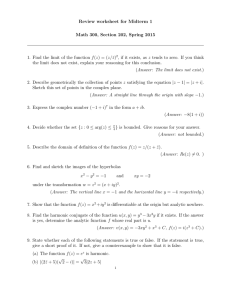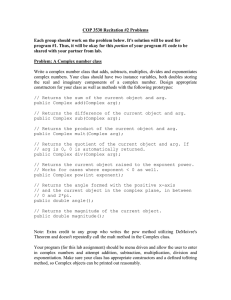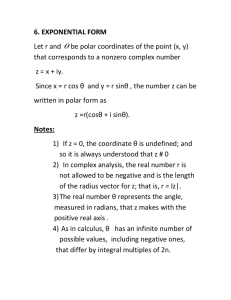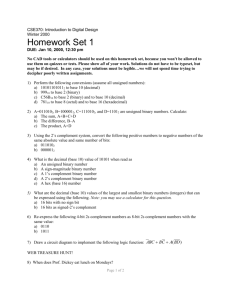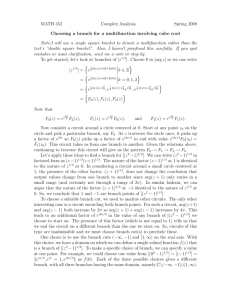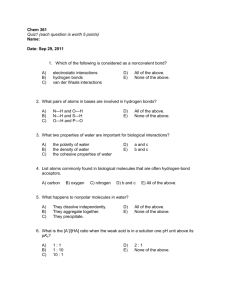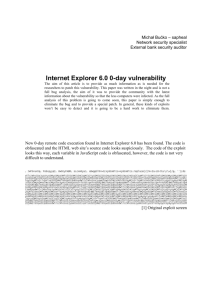Calculator Slides pdf
advertisement
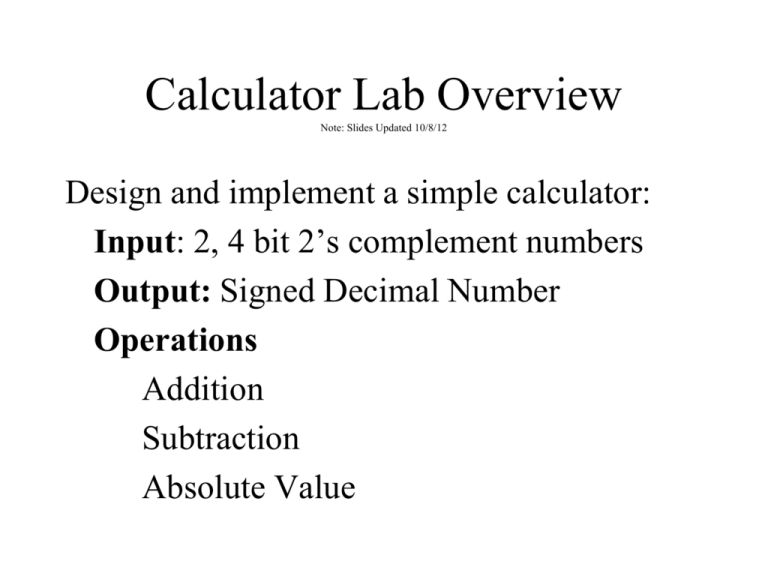
Calculator Lab Overview Note: Slides Updated 10/8/12 Design and implement a simple calculator: Input: 2, 4 bit 2’s complement numbers Output: Signed Decimal Number Operations Addition Subtraction Absolute Value Restrictions • You will learn how to implement arithmetic operations at a binary level, so: – MAY NOT use Verilog Arithmetic Operators + and – • Solution would be Trivial!! – May only use 1, N-bit adder • Use Example from Lab 2 – Top Level Design may be either Schematic or Verilog – May use continuous “assign” operators • AND &, OR |, XOR ^ , 1’s complement ~, , “?” operator, etc. – May use any form of schematic entry Review: Addition With Boolean Operators Half-Adder x y Sum Carry 0 0 1 1 0 1 0 1 0 1 1 0 0 0 0 1 Sum = (~X & Y) | (X & ~Y) = X ^ Y Carry = X&Y Can be implemented with simple Boolean operations!! Review: Adding Sets • Half-AddersFull AddersN Bit Ripple Carry adders (Lab 2). Bn An Cout FA B1 A1 C2 Sn FA S1 Add stages as needed. B0 A0 C1 FA S0 Cin Subtraction with Boolean Operators • Perform 2’s complement of argument to be subtracted then add: For example, 3 – 1 3 + (-1) = 2 0b011 3 0b111 -1 0b1010 2 (3 bit) Carry to 4th bit position must be ignored. Implementing 2’s Complement • Take 2’s complement + 1 Bit wise 1’s complement A0..An ~ of set B0..Bn Cin=1 N Bit Ripple Carry Adder Set carry = 1 to implement +1 S0..Sn+? Consider how many bits are required to represent output range Absolute Value Implement absolute value by testing for negative value and then subtracting. For example, if (arg = = neg) arg = 0 – arg else arg = arg. How can you tell arg is negative? How many bits do you need? Consider a simple, 3 bit calculator. What is the range of input values? Min ? 0 Max ? What is the range of output values? Min ? 0 Max ? How many bits are required to represent the output range? Sign Extension Recall the example used earlier: 3 – 1 = 2 0b011 0b111 0b1010 If 4 bits are required to represent the output, the result is not 2 but 0b1010 = -6!!! This problem can be fixed by sign extending the input values to match the size of the output. 0b0011 0b1111 0b10010 The 4 bit result is now correct and the 5th bit is ignored. High Level Functional Organization to Implement Addition and Subtraction Additional functionality will be required to implement absolute value Consider 3 – 1 = 2 What is the binary value on each data path segment? N Bit For example b011 Arg 1 Arg 2 Adder b0011 A Sign ext Sign ext Add/Subtract 1s ~ B Cin 2:1 Mux Control Logic Arg 2 Output Binary to Seven Segment Encoder Binary to Seven Segment Encoder, cont A few more points • Unlike Previous Pre-Lab Assignments, this Pre-Lab is a Partial Design Solution • Need to Implement Absolute Value and Binary to 7-Segment Decimal Encoding for In-Lab • Post-Lab Assignment Requires some Simulations
